Know Your Dogs Game
by Samantha Neville
An All vs All Strategy Card Game for 2-4 Players
Ages 9+
Game Description:
Players compete against each other to group the dog breeds into the correct groups, but watch out for those tricky cats!
Goals
- Finish the game with the most points
- Collect the correct breeds of dogs for each round
- Be the first person to run out of cards to win each round
Rules
● Deal 7 cards to each player, youngest player goes first
● Round one – Hunting Dogs
○ Action 1 – Players draw a card
○ Action 2 – Players analyse if they have any of the 6 dog breed cards that match the round requirements
○ Action 3 – Players have one or more of the six cards they need so they lay the cards down face up on their turn
○ Action 4 – Players discard to end their turn and to end the round if they have the full card requirements
● Round two – Working Dogs
○ Action 1 – Players draw a card
○ Action 2 – Players analyse if they have any of the 6 dog breed cards that match the round requirements
○ Action 3 – Players have one or more of the six cards they need so they lay the cards down face up on their turn
○ Action 4 – Players discard to end their turn and to end the round if they have the full card requirements
● Round three – Companion Dogs
○ Action 1 – Players draw a card
○ Action 2 – Players analyse if they have any of the 6 dog breed cards that match the round requirements
○ Action 3 – Players have one or more of the six cards they need so they lay the cards down face up on their turn
○ Action 4 – Players discard to end their turn and to end the round if they have the full card requirements
● The cat cards are worth –50 points
○ Players may collect 2 cat cards to equal +100 points this does not apply to more than two cat cards
○ Collecting cats does not end the turn it only adds extra points.
● Mixed Breed Dog cards are wilds and can be used in all three rounds and categories
○ Players can only use up to two Mixed Breed Dog cards as wilds
○ The wild cards only count for the dog groups players are collecting for, they cannot be used in place of a cat.
● Players may draw from the discard pile outside of their turn but must pick up then next card underneath the initial card in the discard pile as a penalty
● When you lay down your cat cards and you have some of your dog cards on the table but you don’t have all 6 breed cards but you run out of cards you must play another round to actually discard. In the event that you get another dog of the same grouping then you can play it and also end/win the round.
● Each round is worth points
○ Round 1 is worth 25 points
○ Round 2 is worth 35 points
○ Round 3 is worth 45 points
Actions
● Action 1 – At the beginning of every turn in every round a player draws one card to start their turn
● Action 2 – In order to win each round a player has to have their 6 breed cards laid down and discarded their final card to end their turn and the round
● Action 3 – As a player collects each breed card for the correct round requirements they can lay that card or cards down on their turn so other players can see the progress everyone else is making
● Action 4 – At the end of every turn the player must discard a single card from their hand they must also discard the final card from their hand in order to win the round.
Transitions
● Start Game
● Player draws a card
● Player discards a card
● A player lays down the 6 dog breed card requirements for each round
● Player runs out of cards
● End Game
Items
• 92 card deck of dog breeds
o Hunting Dogs
▪ Labrador Retriever ▪ Basset Hound
▪ Weimaraner ▪ Irish Wolfhound
▪ Rhodesian Ridgeback ▪ Golden Retriever
▪ West Highland White Terrier ▪ Beagle
▪ Chesapeake Bay Retriever ▪ Dachshund
▪ Portuguese Water Dog ▪ Mini Schnauzer
▪ German Shorthaired Pointer ▪ Bloodhound
▪ Whippet ▪ Scottish Terrier ▪ Brittany Spaniel
▪ Soft Coated Wheaton Terrier ▪ Vizsla
▪ Airedale Terrier ▪ Cocker Spaniel
▪ English Springer Spaniel ▪ Bull Terrier
▪ Wirehaired Pointer Griffon
o Working Dogs
▪ German Shepherd Dog ▪ Rottweiler
▪ Pembroke Welsh Corgi ▪ Boxer
▪ Australian Shepherd ▪ Great Dane
▪ Siberian Husky ▪ Doberman Pinscher
▪ Bernese Mt. Dog ▪ Cane Corso
▪ Shetland Sheepdog ▪ Mastiff
▪ Border Collie ▪ Rough Collie
▪ Newfoundland ▪ Belgian Malinois
▪ American Akita ▪ St Bernard
▪ Australian Cattle Dog ▪ Bull Mastiff
▪ Alaskan Malamute ▪ Giant Schnauzer
▪ Cardigan Welsh Corgi ▪ Samoyed
o Companion Dogs
▪ French Bull dog ▪ Bull Dog
▪ Standard Poodle ▪ Yorkshire Terrier
▪ Cavalier King Charles Spaniel ▪ Shih-tzu
▪ Boston Terrier ▪ Havanese
▪ Pomeranian ▪ Pug
▪ Chihuahua ▪ Maltese
▪ Bichon Frise ▪ Shiba Inu
▪ Papillion ▪ Dalmatian
▪ Italian Greyhound ▪ Shar-Pei
▪ Miniature Pinscher ▪ Chow Chow
▪ Chinese Crested ▪ Pekingese
▪ American Eskimo Dog ▪ Tibetan Terrier
o All American Dogs
▪ Mixed breed dogs x 12
o Cats in dog costumes x 8
Setup
● Deck of cards in the middle of the table
● Discard pile beside the draw pile in middle of table
● Player deals 7 cards for all three rounds
● Youngest player goes first
● Player may lay down every dog breed card they need for their current round until they reach 6
Identify Meaningful Choices
Meaningful Choices
Meaningful Choice #1
● Drawing a card is a meaningful choice because you have to decide if you want the card someone else discarded for instance in round three if player 1 chose to discard a cat but player 2 is trying to get the extra points they may draw that cat in hopes they will draw another cat from the deck or player 1 will discard a second cat.
● This choice occurs at the beginning of every turn Meaningful Choice #2
● The discard is a meaningful choice because if you get a cat or a dog breed that isn’t in the category of the round then you will want to discard them. When I drew a cat I had quite a bit more pressure to discard it before I was stuck with the -50 points.
● This choice occurs at the end of every turn.
Meaningful Choice #3
● Choosing whether or not to use a mixed breed dog or wait for another purebred breed of dog for the group in the hand is a meaningful choice because the player has to decide if they want to win with 6 dogs that are all purebred or maybe they feel that mixed breeds deserve love too and they want those more than the purebred dogs.
● This choice occurs when you draw a mixed breed dog.
Explanation
How do the Meaningful Choices listed above impact your game? How do they improve the gameplay? What would the gameplay be like without these choices?
The Meaningful Choices I listed above impact my game by adding more strategy and interest in order to win the game. They improve gameplay by adding fun, interesting competition that is non-violent. This game should be more relaxing when you are done playing it even if you were working hard to win and prevent the player next to you from getting more points in the final round. If the game did not have these choices then the player would draw a card and just collect breeds of dogs with no reason for them, the player would have no reason to play and it would be very boring with no purpose.
Single Player Playtest #1
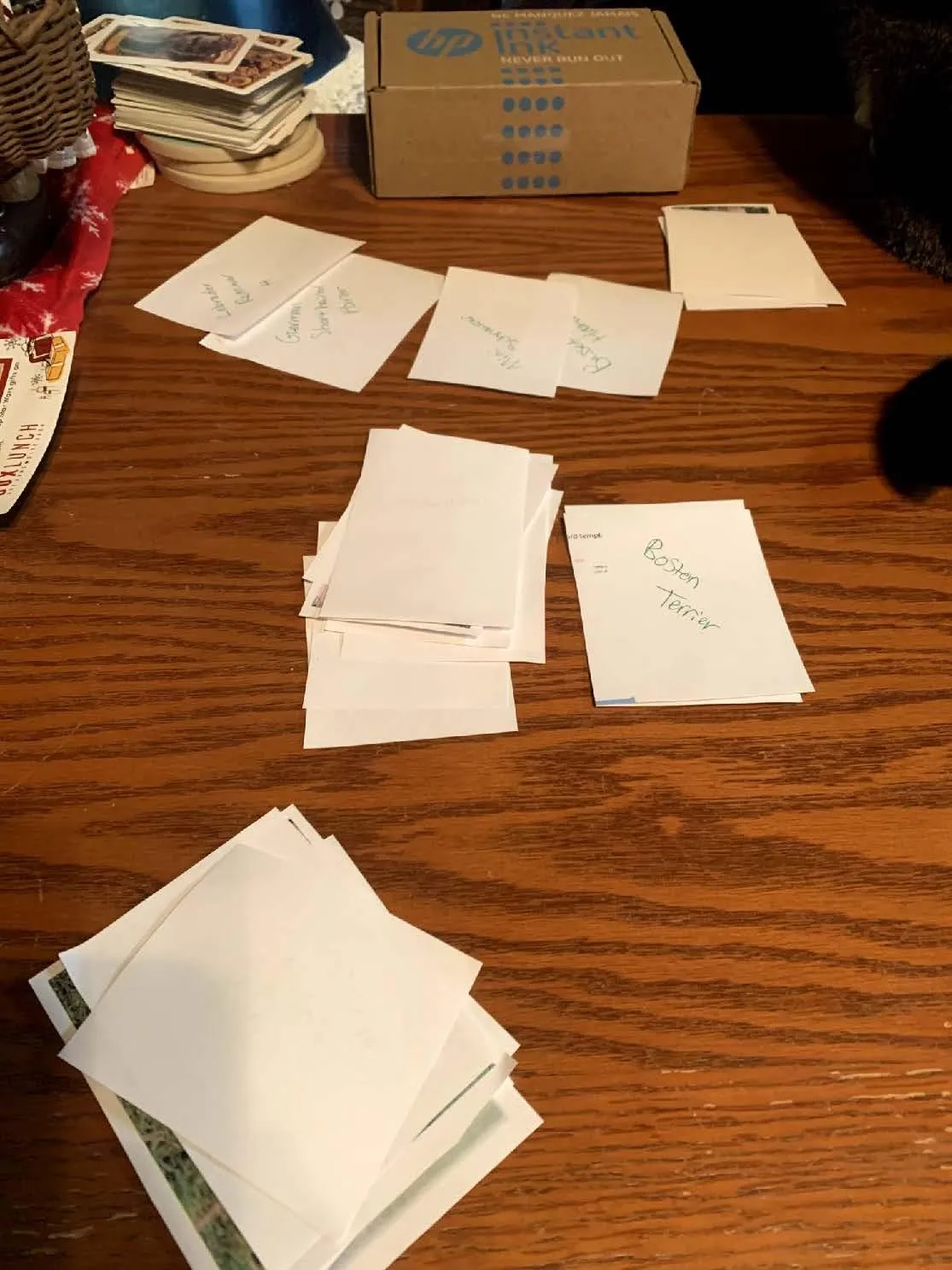
Playtest #1 Questionnaire
1. In 2 or 3 sentences, how would you quickly (but accurately) describe your game to others?
Know your dogs is a card game where you compete against other players to collect all the breeds for the correct grouping in each round. Watch out for the cats!
2. Did you run into any loopholes or dominant strategies with your design? If so, how did you alter the design to fix these issues? If not, what about your design prevented those loopholes?
During my first play through I realized that I did not work through how many mixed breed dog cards you can use in a grouping. I am concerned it could be a form of dominant strategies if I do not limit the number of mixed breed cards you can use.
3. What are some of your thoughts on your design? Did the mechanics you made on paper translate well when actually playing the game? For example: What were the most used actions, least used actions?
Shuffling the paper I cut by hand was difficult and I realized that writing just the names on the cards instead of having the photos made it a little more difficult because I had to slow down and read the breed of dog then remember which group it goes in. Draw card and discard were the most used actions and laying down the correct breed cards were least used actions.
4. Did the player choices in your game feel meaningful? If so, how were they meaningful? If not, why not? What can you do to improve the meaningful choices available to the player?
Yes I felt like almost all of the choices were meaningful. The choices to keep or discard any of the cards they have make it more interesting when you are trying to prevent the player next to you from winning. Where you sit and who you sit by can also be a meaningful choice.
5. How long did your game setup take? How was the presentation and usability of your materials? What improvements can you make for the next playtest to go more smoothly and look more professional? For example: did you use card sleeves, were you trying to shuffle loose leaf paper?
Shuffling the paper cards took the longest. Once I have this integrated into an online program it will be much easier to shuffle and deal. I need to add back pictures to the cards and front pictures and text so all players know what is going on with each of their cards.
Single Player Playtest #2
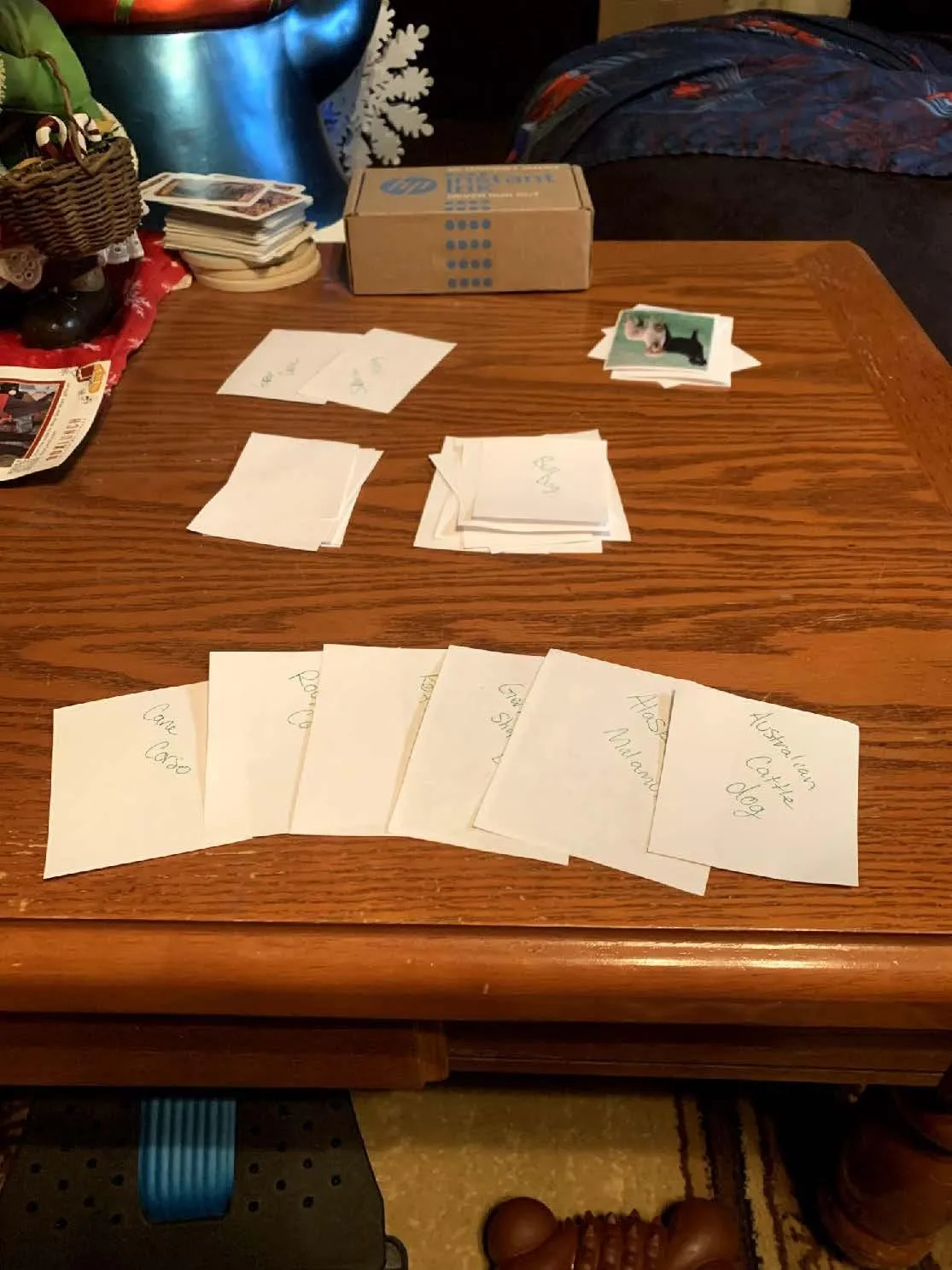
Playtest #1 Questionnaire
1. After a second playthrough, did you run into any new loopholes or dominant strategies with your design? If so, how did you alter the design to fix these issues? If not, what about your design prevented those loopholes?
During the testing I realized that allowing all breed cards to be wild cards is a dominant strategy. I altered the rules to where the wild cards have a limited use now.
2. After a second playthrough, what are your new thoughts on the design? Did the changes you make from the first playtest improve your game? Explain some of those changes and how they improved or detracted from the game experience.
After I finished the second play through I decided I will need to add something to tell people what category of dog breeds they group with. I think they improved the game so that anyone, including those players whom do not know dogs well, would be able to play and have a fair chance at winning.
3. After your presentation updates from playtest #1, how did your play experience improve? Were there any issues with the user experience? How can you continue to improve the flow of your game for the next test? If you did not make presentation updates, what should you do before the next playtest?
I gave my paper cards a second chance and decided that they are very difficult to use. I really need to add pictures, breed names, and the grouping to the cards so the player doesn’t have to remember which breeds belong with which group and so there can be no arguing about different breeds of dogs.
4. Which actions did you use the most, which did you use the least? Were some not used at all? How can you balance out your actions to create multiple, interesting paths to victory?
The first play through Player 2 won by getting all the correct grouping of breeds of dogs the strategy they used was simply draw and discard without thinking too much about it then laid the group of cards down at one time. Player 1 was trying to figure out how many cards the other player had while laying down every hunting dog card they got during the first round.
5. Describe the decisions you made throughout a few example turns in your game. Point out each major decision, and quickly describe how that decision was meaningful.
During round one Player 1 started out with only one hunting dog breed in her hand. Player 2 started with 3 of the hunting dog breed cards in her hand. Both players drew a card for their turns Player 2 chose to keep their cards secret in their hand while player 1 chose to lay every hunting dog breed they got down on each turn. Player 2 was able to keep the suspense and give false hope to the other player by not laying their hunting breeds down right away and waiting until they had all 6.
Flowchart
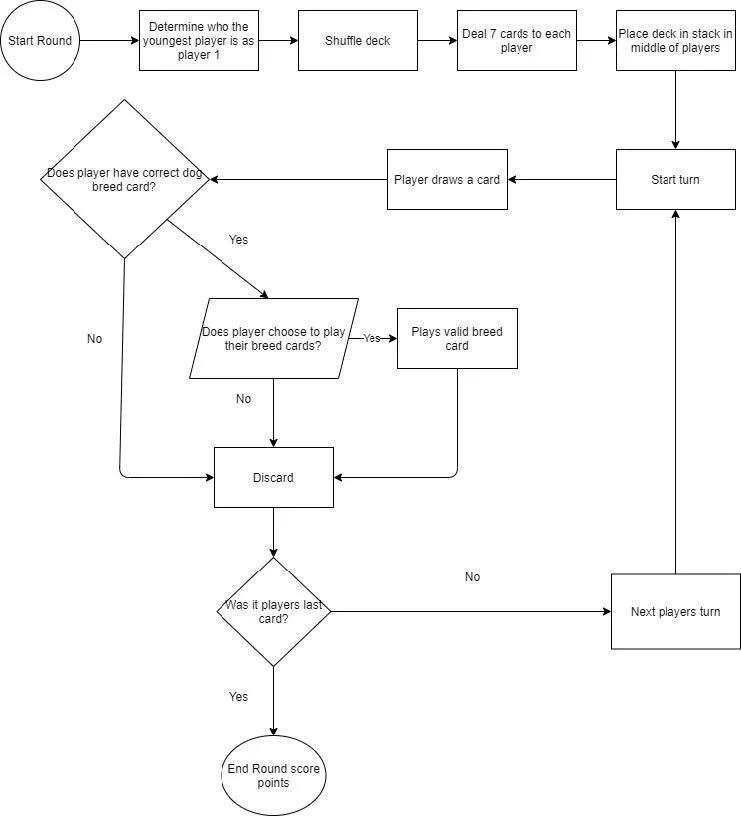
Group Playtest #1
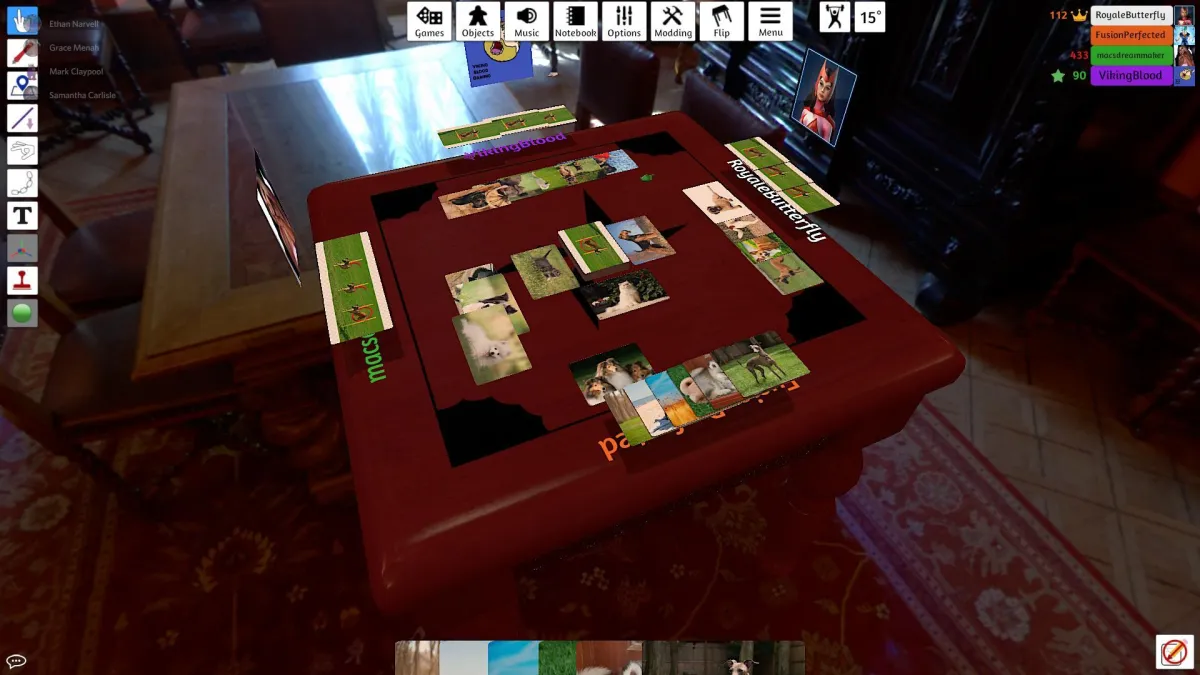
Group Playtest #1 Questionnaire
1. Describe the Meaningful Choices available to your players during this playtest. Did these choices lead to interesting strategies, or was there a dominant strategy / obvious choice always available? Were there multiple viable ways for players to achieve victory? What improvements can you make from these observations to enhance the Meaningful Choices available?
The Meaningful Choices available to each player is which card to discard. The players feedback to me said they really enjoyed seeing what cards the other players were going to discard. I was also given feedback that the cat cards really threw them off initially since it is mostly a dog card game. They had a little bit of a hard time because the cards hadn’t been named yet so I need to name the cards to make it fair for everyone.
2. Did your Flowchart do a good job of explaining the player actions and overall flow of the game? What questions did your players ask you during the playtest about your rules? What steps will you take to clarify those areas? Were there any instances or situations that were not covered by the rules or Flowchart at all?
The flowchart they said made sense to them after they saw how it was played. Because I had dog cards and cat cards they were not expecting the game play with such kinds of cards. I asked them if they thought I should change anything in my flowchart and they said once they got over the shock of the cards they found it very easy to follow.
3. What are some of your thoughts on your design? Did your players have any contributions or thoughts on your design? Are you planning on changing your design based on those observations? Explain your decision.
I needed to name all the cards so there wouldn’t be a dominant strategy for people who knew dog breeds well. One player suggested that I throw out all the cat cards, I asked if they felt they did not add to the game and the player said oh it is great in this game I just hate cats. I decided not to change my design based on that suggestion since they said they did not have a complaint with the actual reason they were in the game.
Group Playtest #2

Group Playtest #2 Questionnaire
1. After your updates from the first playtest this week, describe the Meaningful Choices your players made this time. Did these choices lead to interesting strategies? Did you eliminate any dominant strategies, or are they still present? What other improvements can be made to the mechanics of the game?
Because I updated the names on the cards the Meaningful Choices were easier to figure out for the players. They were able to choose which breeds were the breeds they needed instead of trying to guess at it the whole time and be wrong if they did not know that much about dogs. It made it more competitive and fun for the players. I realized that I added a collect two cat cards and didn’t figure out how you would do that on the final round so I need to change that.
2. After updating your rules and Flowchart, did players understand how the game was to be played? Did you encounter new questions that were not addressed in the rules? How can you continue to clarify and simplify the explanation of your rules?
Yes players were able to play this test much more smoothly. I did not have to explain a whole lot to them at all this time. I had a couple new questions this time which was if each round is worth the same points what happens if three different players win each round. So then there would be a three way tie and that would have no resolution. I had put the cat collection in place for that but the players chose not to risk keeping the cats in round three.
3. How did your design changes after the previous playtest alter the gameplay? Were these good changes, or did they negatively affect the game? Are you finding that these iterations are smaller tweaks or larger mechanical changes? With this in mind, do you feel like you are close to the “final design” of your game?
The design changes were helpful for the second playtest by helping it go smoother, faster, and make it more interesting for the players. They improved the gameplay for everyone and made the players enjoy playing the game instead of having to figure out what was happening with the cards first. They seem to be smaller tweaks at the moment. I do feel like I can finish up the last touches of the game over the next few play tests.
Group Playtest #3
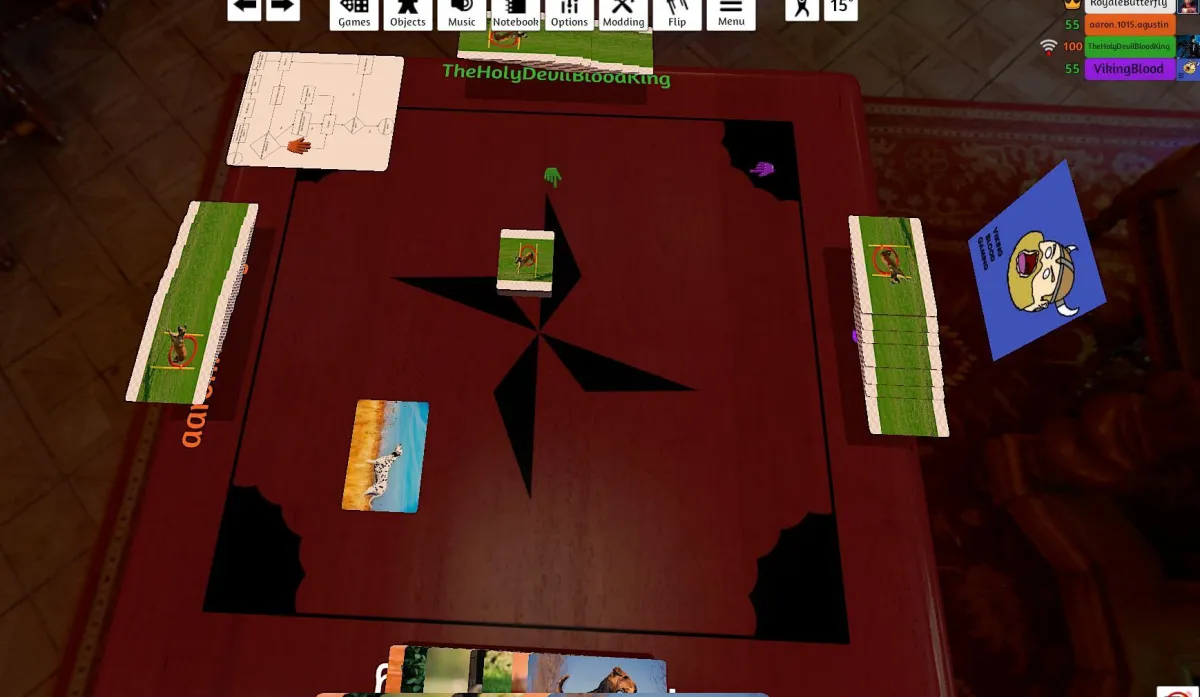
Group Playtest #3 Questionnaire
1. What type of gameplay emerged from this next playtest? Did you encounter different Meaningful Choices for your players, or were they the same as last time? Is the gameplay varied enough to remain interesting for multiple playthroughs?
The players said they really enjoyed this game and that it is fun to learn about the dog breeds. The players asked that I make the cat option through the whole game so they have more strategy and options for winning. In order to make it more interesting I will have to change the game to where the cats can be collected for two of them through the whole game.
2. Were you able to explain your game by only reading from the Rules and Flowchart? Did you need to supplement your rulebook with clarifications and examples? If so, how could you incorporate that information into a more effective set of rules for the next playtest?
Everyone was able to understand the rules and flowchart with ease this playtest without any further explanation. I had to change the cat collection part for the final play test so I will have to explain that in the rules better. I will have to explain the reason the cats are wanted and how they can be added to the strategy.
3. How has the game changed since your original design? Reflect back on the changes and iterations you’ve made since your single player playtests. Think about the critiques and feedback you have gained from other players and how their input has shaped your game.
The game has changed from physical to digital which I did not like and the single player tests did not show me some of the issues that the group play tests did. I got feedback to add names to my cards and change the shape of the cards. I haven’t figured out how to change the card shapes so I will have to keep working on it. Then I also had to change the points systems and add different options for strategy.
RULEBOOK
Thematic Backstory
This card game is all about dogs and what they were bred for or if that job still exists today. Do you know your dogs? If you wanted to get into hunting with dogs do you know which breeds would work best? Test your knowledge of dogs in this card game.
List of Game Components
• 92 card deck of dog breeds
o Hunting Dogs
▪ Labrador Retriever ▪ Basset Hound
▪ Weimaraner ▪ Irish Wolfhound
▪ Rhodesian Ridgeback ▪ Golden Retriever
▪ West Highland White Terrier ▪ Beagle
▪ Chesapeake Bay Retriever ▪ Dachshund
▪ Portuguese Water Dog ▪ Mini Schnauzer
▪ German Shorthaired Pointer ▪ Bloodhound
▪ Whippet ▪ Scottish Terrier ▪ Brittany Spaniel
▪ Soft Coated Wheaton Terrier ▪ Vizsla
▪ Airedale Terrier ▪ Cocker Spaniel
▪ English Springer Spaniel ▪ Bull Terrier
▪ Wirehaired Pointer Griffon
o Working Dogs
▪ German Shepherd Dog ▪ Rottweiler
▪ Pembroke Welsh Corgi ▪ Boxer
▪ Australian Shepherd ▪ Great Dane
▪ Siberian Husky ▪ Doberman Pinscher
▪ Bernese Mt. Dog ▪ Cane Corso
▪ Shetland Sheepdog ▪ Mastiff
▪ Border Collie ▪ Rough Collie
▪ Newfoundland ▪ Belgian Malinois
▪ American Akita ▪ St Bernard
▪ Australian Cattle Dog ▪ Bull Mastiff
▪ Alaskan Malamute ▪ Giant Schnauzer
▪ Cardigan Welsh Corgi ▪ Samoyed
o Companion Dogs
▪ French Bull dog ▪ Bull Dog
▪ Standard Poodle ▪ Yorkshire Terrier
▪ Cavalier King Charles Spaniel ▪ Shih-tzu
▪ Boston Terrier ▪ Havanese
▪ Pomeranian ▪ Pug
▪ Chihuahua ▪ Maltese
▪ Bichon Frise ▪ Shiba Inu
▪ Papillion ▪ Dalmatian
▪ Italian Greyhound ▪ Shar-Pei
▪ Miniature Pinscher ▪ Chow Chow
▪ Chinese Crested ▪ Pekingese
▪ American Eskimo Dog ▪ Tibetan Terrier
o Mixed Breed Dog cards X 12
o Cats in dog costumes x 8
Game Setup
Shuffle your deck of cards and place the main deck in the middle of the players. Deal 7 cards to each player for every round. When a player discards make the discard pile next to the draw pile in the middle of the players. Players should lay down any cats and dogs collected in front of them on the table. Round 1 is Hunting dogs, Round 2 is Working dogs, and Round 3 is Companion dogs.
Objective
The goal is to win each round with the most points. Don’t be afraid to risk keeping some cats around. Collect 6 dog breed cards of the correct category for the round.
Turn Overview
Player turn begins with drawing a card from either the draw pile or discard pile. Player chooses the valid dog breed cards for the round to lay down on table or keep hidden. If player is collecting cats, they must have two cats to earn the +100 points. Player discards a card to end turn.
1. Draw a card from the draw pile or discard pile, keep them hidden.
2. Choose which dog breed cards are valid for the round.
3. Decide if you want to lay your dog breed cards on the table or wait until you gathered all 6.
4. If you have two cats you may lay them down on the table, if you only have one you must choose whether to keep it or discard it.
5. Discard card to end turn
Details Regarding Various Game Mechanics
Here are the actions the players will be using.
1. Each player is dealt 7 cards at the start of every round
2. Every player draws a card at the start of their turn, you may draw 1 card from the draw pile or discard pile
3. Drawing a card from the discard pile out of turn results in taking the card directly underneath it as a penalty card.
4. Player has the choice to lay down all their current dog breed cards that align with the round being played or keep them hidden in their hand
5. If player draws a cat card and doesn’t discard it and also doesn’t collect a second cat card the player will lose 50 points from the score.
6. If player collects two cat cards and they lay them face up on the table in front of them they add 100 points to their score.
7. In order for the player to end their turn they must discard a card.
8. When player draws or has a Mixed Breed Card they act as a wild card to complete their breed set of 6, but the player may only use up to 2 mixed breed cards in their breed group.
Ending the Game
The player with the most points after all three rounds wins. Round 1 with Hunting dogs is worth 25 points, Round 2 with Working dogs is worth 35 points, and Round 3 with Companion dogs is worth 45 points.
● When you lay down your cat cards and you have some of your dog cards on the table but you don’t have all 6 breed cards, yet you run out of cards you must play another round to actually discard. In the event that you get another dog of the same grouping then you can play it and also end/win the round.
Examples of Play
Your turn should start with drawing a card and looking at your cards to see how many breed cards you can play or count them but keep them hidden from the other players. If you have a cat in your hand you can decide if you want to keep the cat card to collect a second one to earn the extra 100 points. After you made your decisions on the cards you have you may discard one card to end your turn. The next turn is by the player sitting to your left. The turns repeat until one player runs out of all their cards in their hands. If you do not collect the cats and you lay down your 6 breed cards you may discard the extra card in your hand.
Frequently Asked Questions (FAQ)
In the FAQ, you can list answers to some frequently asked questions from your playtesters. You should first try to write your rules and instructions in a way that answers these questions outright. If there is not a natural place to answer that question and it cannot be solved with a rule change, you may want to include it here.
Q: If the player plays both cats does that also end the round?
A: No, the cats are to add extra points.
Q: Does the Wild Cards count towards collecting cats?
A: No, Mixed Breed Dogs are not cats.
Documentation Updates (Patch Notes)
Here you will be keeping track of the changes of your Rulebook as it continues to take shape. You should be noting important updates and when they were made. Smaller updates like spelling and grammatical fixes are not necessary to list. Think of this as the Patch Notes to your game, which you keep a running tally of to keep track of your design history. It is important to keep track of the changes you make so that you can reference them for future changes.
Version 0.2 Observed Playtest 1
• Clarified rules of what ends the round specifically when discussing cats and dogs. Clarified that playing two cats does not end the round or the game only adds extra points.
Version 0.3 Observed Playtest 2
• Added a rule when playing a round and a player runs out of cards in their hand but doesn’t discard and clarified some rules on the discard and playing of the breed cards to end the round.
Version 0.4 Observed Playtest 3
• Clarified rules about how wild cards can be used and can’t be used.
Quick Reference (Cheat Sheet)
Goals: To win the game with the most points.
Player Turn:
1. Draw a card from the draw pile or discard pile, keep them hidden.
2. Choose which dog breed cards are valid for the round.
3. Decide if you want to lay your dog breed cards on the table or wait until you gathered all 6.
4. If you have two cats you may lay them down on the table, if you only have one you must choose whether to keep it or discard it.
5. Discard card to end turn
Card References:
Hunting dog breeds for round 1, Working dog breeds for round 2, and companion breeds for round 3. Cat cards are worth -50 points unless you collect 2 of them. Mixed breed dog cards are wilds you can use up to 2 to complete your grouping.
Observed Playtest #1

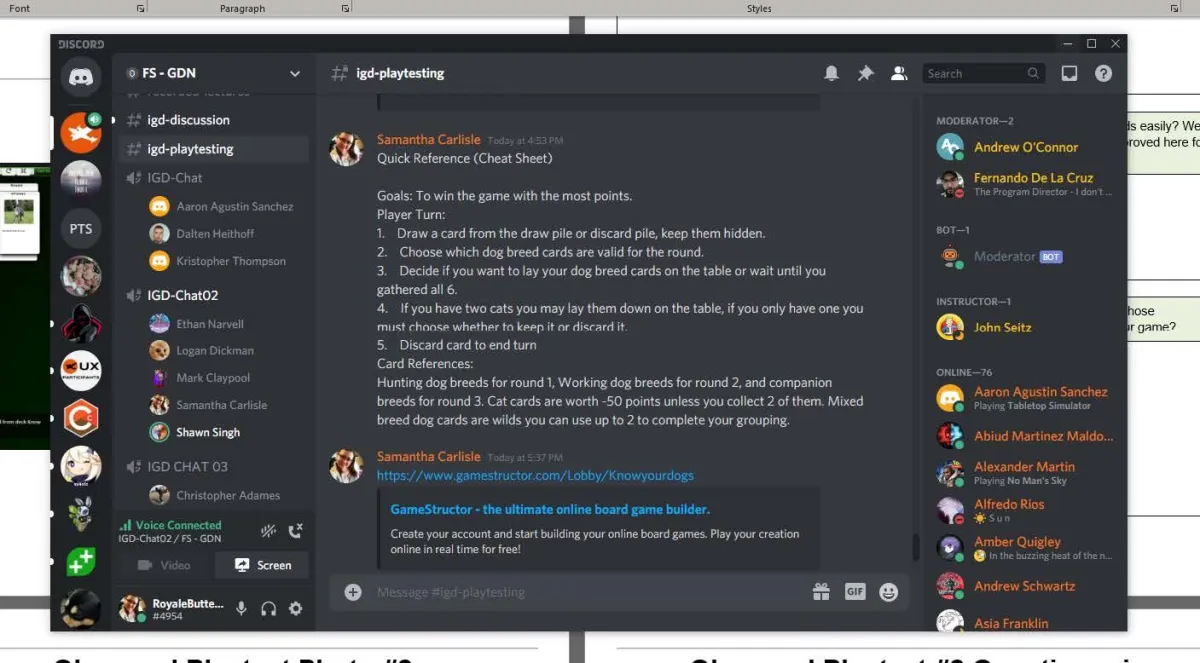
This playtest lasted 20 minutes.
Observed Playtest #1 Questionnaire
1. Were your players able to understand the rules and mechanics of your game by reading the rules you provided? What changes would you make to how you present the rules for the next playtest? Did your players use the Quick Reference (Cheat Sheet)? Did they find the information clear and useful? What changes could be made to improve the Quick Reference?
The players were able to play my game from reading the rules and picked up how to play quite quickly. During the first playtest they used the reference sheet if they got very involved in their strategy and would forget where they were at in their turn. The players for this playtest said my rules were some of the clearest rules they had read and used so far. I asked them if I should add color and pictures and they said it was actually easier reading it how I have it set up for this game. I haven’t been able to come up with any ideas on how to adjust the quick reference.
2. Tell us about some of your observations from the playtest. Were players getting frustrated, when and where? Were they excited? What were some notable reactions to the game? Try to explain why you think these reactions happened and if they were a part of the design goals of the game.
The players were enjoying themselves and two of them seemed to have the same sort of strategy where as player 3 was keeping his cards hidden. They were all very excited to play and were enjoying playing a game that was teaching them yet also fun with animals involved in it. The pixelated pictures greatly amused and annoyed the players, if this were a game that was being shipped they would need to be clearer or maybe lower resolution pictures to begin with. I was surprised to hear about how much these players were enjoying the game and the strategy with the simplicity of it. I think that these reactions happened due to enjoyment of all their choice options and how they all had the same fair chance at winning as another player.
3. How was the user experience of the game? Were players able to shuffle and deal cards easily? Were the descriptions and text on the cards, rules, and Quick Reference clear? What can be improved here for the next playtest?
The flow of the game was very streamlined like they had all played it many times after they had read the rules. The players told me they loved having the small amount of information on the cards it helped them plan their next move easier and see how others were playing their cards. I have to improve the clarity on when the round ends and how the cats play into the end of a round.
4. Describe the meaningful choices you’re providing for your players. Are they using all of those meaningful choices, or only some? What changes to your design could further improve your game?
4. Describe the meaningful choices you’re providing for your players. Are they using all of those meaningful choices, or only some? What changes to your design could further improve your game?
Observed Playtest #2
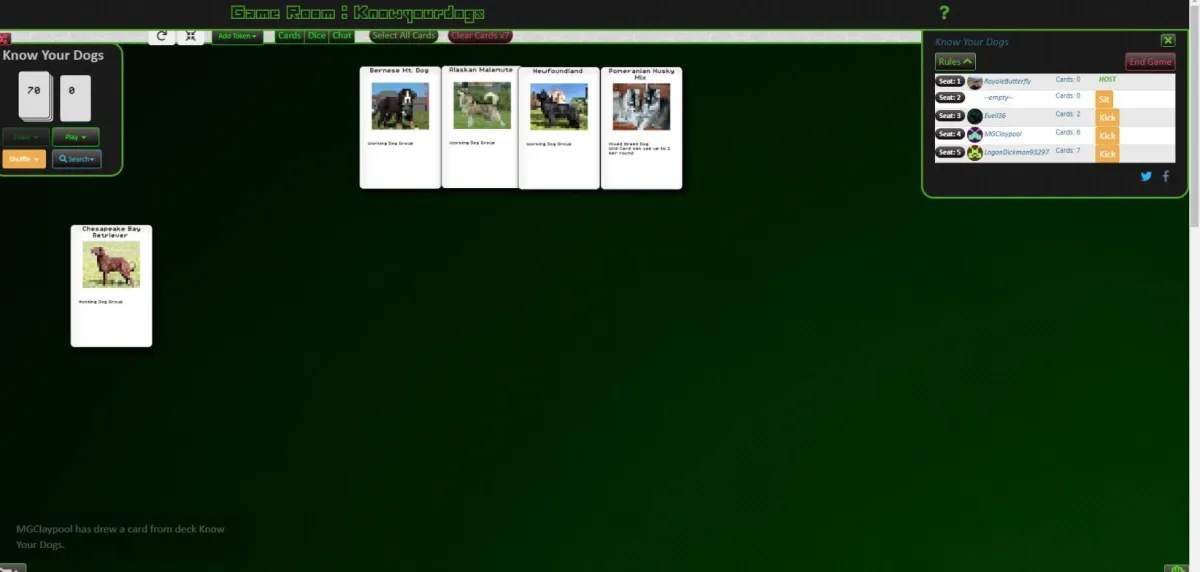
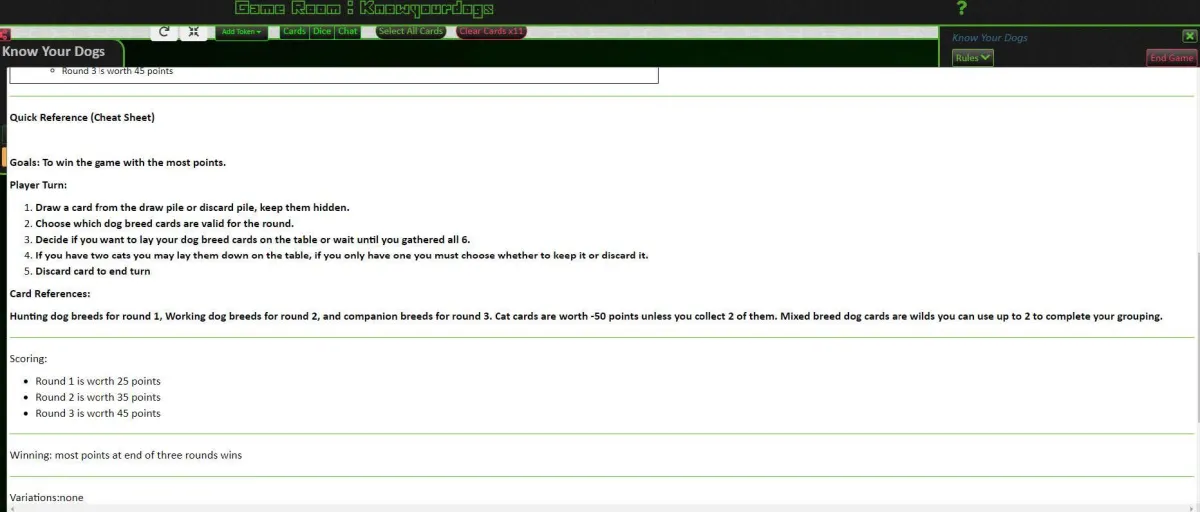
This playtest lasted 20 minutes.
Observed Playtest #2 Questionnaire
1. Did your group encounter any dominant strategies during the second playtest? Did you encounter any unexpected player strategies?
During this playtest the players asked the question if I gave the cats too many points and if they are a dominant strategy. I wrote it down the question and observed how my mechanic is supposed to work vs how they thought it might. They all had the same opportunities to draw cats or discard them, they all had the same options to play a cat and try to get another cat or hide said cat so no one knew you had one. After the third round and everyone using the cats the players were still a little upset because player two was able to collect two of them where as player one and player three were only able to collect one each before the round ended. This is how I designed it though so I didn’t see any dominant strategy in it. All three of them could have ended up with 2 cats as well.
2. How long did it take for the group to learn your game this time? Were your rules and Quick Reference updates effective? Are there any other iterations you can make to improve the clarity of your game rules? For Example: Provide a Sample Turn.
It took one person a little longer to learn this game. He said he had never played a game like this one before and had no idea what to do. He had to play a few turns before he started to understand. He voiced his confusion and understanding multiple times. I almost jumped in when the other two players told him he just needed to give it a shot and just try to play the game and not break it down. When I asked the confused player what I could do to clear up his confusion for the future he said he had just never played any games like this before and that the choices the game gave them he found pointless because he would just never play such a simple game. I had been expecting this kind of a response for all of my playtests since I made it for kids around 9 years old.
3. What sort of gameplay dynamics emerged within this group? How did those dynamics affect the gameplay? Would you encourage or discourage those dynamics for future games?
The game play dynamics between the members became very monotonous and they seemed bored. They stopped interacting with each other and just drew a card played a card and would say end my turn. I asked what I could do to change the gameplay and they said they really enjoyed the game itself they just said the energy they got off other players made it dull and they just wanted the game to be over. I would discourage groups of people who aren’t at least open to learning about dogs from playing this game in the future.
Observed Playtest #3
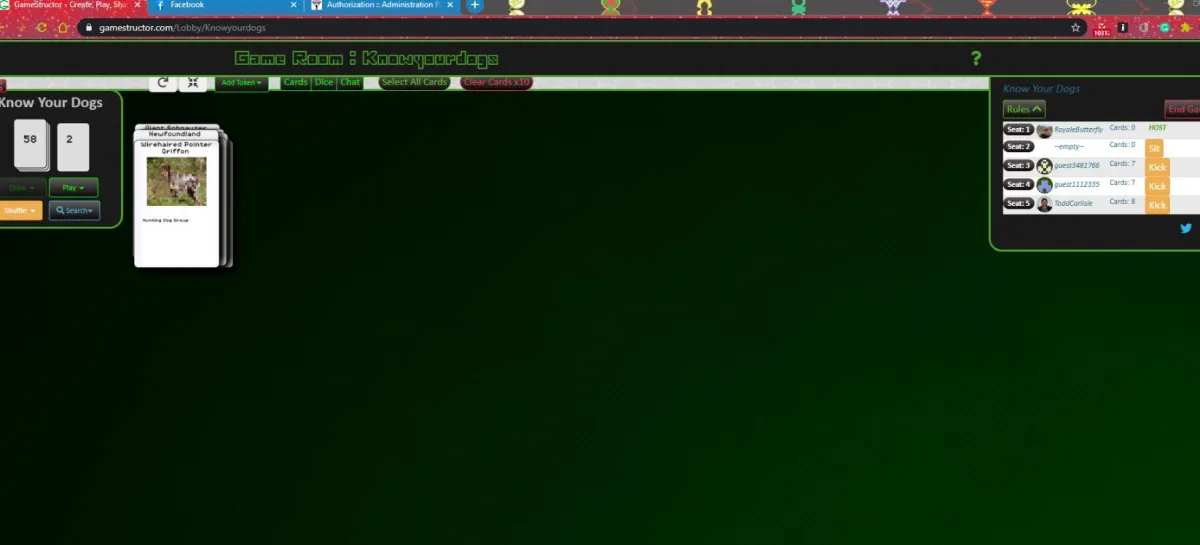

This playtest lasted 45 minutes.
Observed Playtest #2 Questionnaire
1. Can you put this version of your game down in front of a group of people, walk away, and have them fully understand how to play the game? If yes, how did you achieve this. If no, what needs to be done to get there?
For Example: Are your Rules clear? Is your Quick Reference helpful? Are the cards concise and descriptive?
I asked each player privately this time more detailed questions to get full responses and they all said that if they were to get this game from the store with the rules I have in it they would easily be able to sit down and play it quickly and often. I listened to player feed back often, I used the information from every playtest and each kind of different type of person and how they played. I also made a game I would have loved to have had when I taught my 4-H kids. I tried to come up with mechanics that would make a good simple game to relieve stress.
2. Did each gameplay session feel unique? Were new strategies and interactions happening each time a group played, or was the same strategy used every game to win? How can you ensure that your game remains interested and replayable?
At first I was concerned that each play test would be the same and I wouldn’t get valuable information. I was wrong every single play test was different even the couple of people I had that were the same from play test one to play test two ended up changing how they played based on the new players I brought in every time. This group knew nothing about my game at all and I got the most interaction from them. Not a single player won every round nor did they win every game for the two that had played my game twice. They were forced whether they wanted to or not to change up how they played if winning was their goal. All the players all said that they felt refreshed after playing my game and they would happily replay it again. After this final playtest all 3 of my players wanted to replay it right then and told me I should make it physical so they can play together in person one day.
3. What feedback did you get from your final group of play testers? What were their impressions of the game? Did they offer any helpful or unique insights on the design of your game?
The final group of players asked me to change the rules so they could cheat. I told them I made my rules the way did so there would be no cheating. They liked that they all had the same chance of winning and player 2 actually started out with negative points after round 1 and ended up winning the game. They enjoyed the interactions with each other to get to those points. They said my game helped them relax and made them want to play more.
Final Reflection Questionnaire
Here you will record your experience with documenting, prototyping and testing your first game design. Go into as much detail as possible, this is incredibly helpful when you come back to reference this project in the future.
1. What did you learn about game design documentation? (two paragraphs minimum)
I learned that game design documents are very important. They are important because of how they make you break down your game ideas and test them. If your idea seems sound on paper but when you start to play test it just doesn’t work then you can go back to your document and see what needs to be fixed and brainstorming how to fix it.
Game design documents also make you think of games in a design way and a how would someone enjoy this game and is this kind of a mechanic interesting or overpowering? You start asking questions like how would we do this in a boss fight or how can I make my idea a reality and not just talk. I found this encouraging in a way that shows me I can make something real and playable too.
2. What did you learn by using the iterative design process? (two paragraphs minimum)
I learned how important polishing on mechanics is in game design. Clarifying rules so people don’t have the options to cheat. Changing some math here and there to make sure that one person won’t always win. Every small and big detail is important.
I learned that making games even card games is more difficult than I initially thought but I enjoyed the challenge. I learned more about myself and my capabilities as a player and as a developer. I was excited to learn how I can bring other players together how even small things that seemed insignificant to them could be loop holes to others.
3. What did you learn about play testing? (two paragraphs minimum)
I learned that play testing is extremely important. I used to think that game companies did not actually need play testing and that it would be a waste of time. Now though I see how many other kinds of people can see your game with fresh eyes even if they wouldn’t normally play that type of game. It was really cool to see how others thought or how they learned in order to play. Being open to critique is very important but also being wise enough to filter through it for the best of your game and future players is a skill that is learned.
Play testing really teaches you the designer where your flaws are in the design, the mechanics even the theme sometimes. Somethings the designer may have found amusing the players may not have understood. Play testing many times shows you both sides of different opinions about rules as well.
4. What did you like about your game? What didn’t you like? (two paragraphs minimum)
I really like the dog part of my game and how I added the cats. I know my 4-H kids would have loved this game and playing it with each other. I did not like having to make a bunch of smaller choices and decisions but realized it wasn’t so bad once they were done. I could also see the impact every small detail or phrasing had on the game play.
I loved how people were able to feel less stressed after their game and how many were surprised they could learn new things in a fun way. Some players even learned things about dogs (including myself) about dog breeds they didn’t know even when they thought they did.
5. How can you improve your process the next time you make a game? (two paragraphs minimum)
I have wondered how I can improve my process a lot. I think networking is a big part of game design and play testing. It is hard to get important opinions or functions and mechanics down without other people. I saw many people in the class for this case that were unwilling to be play testers themselves which made me want to help others and then maybe they would want to help me.
Making the atmosphere fun and enjoyable even for people who are introverted is also something that I believe can be achieved with the right attitude and optimism. Writing out my ideas and any and all questions I have for my game will be incredibly helpful I learned quickly that I cannot keep it all locked away in my head. I also learned that using people that do not know anything about game design as a sounding board sometimes helps because they come at things with a fresh perspective.